|
|
|
|
|
 |
Edition 2 Book Cover
Featuring the Dorogoj children,
Fejge or Szyma, Bencyjon, Frume
(All born in Radzilow)
Read article about them |
|
| |
|
|
The walls were stone, the doors were wooden;
inside, there was the threshing floor and mows for storing the grain on both
sides. It all happened before the harvest; the mows were still empty, and that's
where children were thrown in through the holes. Long bars were put up and then
fixed in position with heavy stones to block the doors so that the Jews
wouldn't escape.
Janina Staniurska, a witness I found
in Gdynia: "I was twelve years old. Some people were hiding in the rye and those
furious thugs armed with clubs were searching the fields. I was going home from
the pasture by the Matlak river; there was a boy pasturing our cow I had just
carried some food to a boy who was pasturing our cow. It was late in the
afternoon. I saw someone running towards me with a club and yelling "You're a
Jewess." He dragged me towards the barn. And there, good Lord, people were being
burned alive, they were trying to run away, climbing the roof and jumping down. Two
neighbors who lived nearby stood up for me, saying, 'She's not Jewish, leave
the szoferowna [driver's daughter] alone.'
That's what they called me, because my father was a driver. Later they explained
to me those men had come from Wasosz, and that's why they didn't know us. I was
scared of passing that place ever since."
There is no doubt about who set the
building on fire; it was Jozef Ekstowicz. This is something many witnesses
remember. He probably used a few tanks of kerosene. Those trying to escape were
shot at.
Halina Zalewska: "Jozek Klimas was
short and fat, so his buddies had to help him climb. People used to call him
Klimas or Klimaszewski because he had been raised by his grandmother named Klimaszewska, but Ekstowicz was his real name."
Andrzej R, who preferred to remain
anonymous: "I saw Jozek douse the kerosene on the barn. Then he chased a girl
who managed to break out of the building. He caught her in the rye and killed
her."
Jozef Ekstowicz alias Klimaszewski
(in the 1948 interrogation protocol): "The murder was instigated and performed
mainly by Dziekonski, Godlewski and the Kosmaczewskis. They were armed with
rifles and forced us to douse petrol on the barn. They helped us [the other man
setting the barn on fire was a stranger from Karwowo] climb the building and we
spilled the petrol all over the roof."
Henryk Dziekonski (in the 1949
interrogation protocol): "It is not true that Klimaszewski, under-age at the
time, was forced to set the barn on fire; in fact, he did it out of free will. He
was given the kerosene by Modzelewski from Radzilow. After dousing the liquid on
the roof and lighting a match, the whole roof was instantly on fire. A moment
later, a man in burning clothes ran out of the burning building. Miroslaw
Strzelecki, who was standing close to me, shot at him. Right after the shot, the
man made a violent convulsive jolt."
Boleslaw C., who preferred to remain
anonymous: "I saw how they were rounded up inside and how the fire was set. How
they were crying! Most of them were little children and elderly people. The
babies were thrown in through the roof."
"Why were you there?"
"Out of curiosity. That's why many
people came there, mainly youngsters and some women too. Some had guns, but
most of them just had sticks and clubs. One Jew was running through the turf.
And there was a man standing there with a Mauser rifle, completely boozed up; he
aimed at the Jew and, drunk as he was, he didn't miss."
|
|
|
|
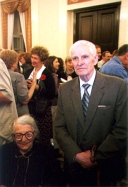 |
|
Marianna and Stanislaw Ramotowski
at a reception given by Pres. Kwasniewski, Presidential Palace, Warsaw, July 2001 |
|
|
| |
|
When Stanislaw Ramotowski heard
about the pogrom, he hid a befriended Jewish miller family in his house and then
ran to town to see what was going on. "When the Poles started rounding up and
chasing Jews, the plundering of Jewish houses began instantly. Did those
people's conscience go blind? They went mad, they were breaking into houses,
tearing up quilts; the air was full of feathers, and they'd just load up their
sacks, run home and come back with an empty sack again."
"Were those men?" I asked.
"Mainly, but I saw a few women, too."
"And children?"
"Those strong enough to carry anything
were happy to. There was such a mass of people eager to do it. I just don't know
where God was at the time."
Jan Skrodzki, son of one of the
murderers, who was helping me find witnesses to the massacre, asked his old
schoolmate: "Can you estimate how many of our people, I mean those from
Radzilow, took part?"
"Better ask who did not, that's easier
to count. But they took part in a number of ways: there were the active ones,
the half-active ones and those just watching. I remember one woman following the
Jews and crying."
|
|
|
|
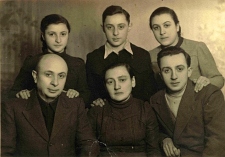
|
|
Finkielsztejn Family
Upon arrival in Israel, 1946
[Bottom row L-R]: Yisrael Finkielsztejn, wife Chaja (nee
Wasersztejn) Finkielsztejn and eldest son Menachem
[Top row L-R]: Chana, Sholem, Yaffa<
Entire family of six survived the Holocaust
Went to Israel, 1946 |
|
| |
|
The Finkielsztejn family managed to run
away from the market square in Radzilow on July 7 to go into hiding. Three days
later, on the 10th, they saw a red glow on the horizon. It was the
barn full of Jews burning in Jedwabne, 14 kilometers away. Later they heard that
people had also been murdered in Grajewo, Stawiski, Lomza, Kolno, Szczuczyn and
in many small remote places, even if there was just one Jew living there.
Chaja Finkielsztejn came to Palestine
in 1946 and wrote down her memories; in the 60's, she deposited it in the Yad
Vashem, where it lay unread for another couple of decades. She described how
people from the village went to see the corpses. Later they would tell others
whom they had recognized; which ones had burned, which ones had suffocated
and on whom only the hair was burned. And how the little children were
untouched by the fire because their mothers had been covering them with their
own bodies. One could almost find out everything about every single Jew that was
murdered in town -- how they acted before death, whether they begged for mercy
or whether they just prayed. People were saying the circumciser's wife tried
persuading the murderers how she realized the Jewish God had left them and that
now she wanted to run to church and ask to be baptized, but she was killed
nevertheless. There was a mason who used to work for the Finkielsztejns before
the war and who, after finishing his work, would always drink a toast to the
Jews that employed him; that man told Chaja he had seen her brother die: "I
could've said a word and they would've spared him, but then I thought, why would
he want to live now that his entire family has been killed?"
The peasants from Trzaski went to see
the priest in Radzilow and told him the Finkielsztejn family wanted to become
Catholic. "The priest told our children to attend the religion classes together
with the Polish kids. After the first class they were very bitter; they had
recognized Jewish clothes on their classmates. When the priest praised our
children for making progress, even our old enemies started paying us visits.
They would always talk about one thing: who had plundered how much and how rich
the Jews had been. They told us the room of Wolf Szlapak [By most accounts, he
was the richest man in town - Ed.] was so full of goods
they carried out a whole chest of silverware for the priest and other useful
things for his housemaid. Murderers were boasting about how brave they had been,
how the Jews had screamed, how they had tortured girls, they would imitate the
victims' grimaces" -- this is Chaja's account of the stories she had to listen
to in the village.
|
|
|
|
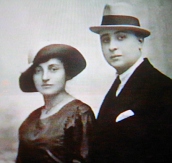 |
|
Chaja and Yisrael Finkielsztejn
Marriage Photo, 1921
[They owned a mill and
were well-off] |
|
|
| |
|
Chaja recognized her own things too,
but she never let anyone notice. One of the village women complained to her that
the Radzilow people refused to share the Jewish clothes with them because they
hadn't taken part in the murder. She was trying to get an opinion out of Chaja,
saying: "I think otherwise. We did no killing, so it's us who deserve to take
what was left after the Jews."
The Finkielsztejns settled in Konopki
and started working in the fields. "The farmers we worked for kept telling us
how lucky we were to become Catholic. This way we could go to heaven, unlike all
the other Jews, who just turn into dust. And we would see the light that other
Jews could not see. They would tell us about a Jew named Dawid, who kept asking
what time it was, even though he was looking at the sun. For after the Jews had
crucified Jesus, darkness set upon them, so that they see darkness even in
daytime. It felt as if we were about to choke on those words."
After the July murder, life in the town
acquired some luster. People were enjoying their new houses, new quilts, new
buckets. The newly acquired houses were being renovated; most of them had been
plundered, so now windows were being replaced, the ovens repaired, the walls
painted white. True, the envy towards those who had managed to plunder more may
have been stronger than the satisfaction. According to Chaja's memoirs, the
question of who got off better was the subject of conversations on the winter
evenings of 1941 and 1942.
The 1949 and 1953 testimonies of Helena Klimaszewska throw some light on the conflicts about the taking over of Jewish
houses. She was the mother-in-law of Jozef Ekstowicz, the man who set the
Radzilow barn on fire. In August 1941 she and Ekstowicz's grandmother came to
Radzilow from Goniadz because she knew that "after the liquidation of the Jews
there were free houses in town," and that "Godlewski was the man in charge of
the ex-Jewish houses." She asked him to "give up one of the ex-Jewish houses."
"Forget it," Feliks Godlewski told
them, standing in the door of a house he'd taken over from a murdered man named
Zandler.
Klimaszewska noticed he already had
four houses.
"It's none of your fucking business. My
brother is coming from Russia, he was deported by the Soviets, and now he needs
a house."
Klimaszewska kept asking until Godlewski lost his patience.
"You weren't even here to help us get
rid of the Jews and now you want houses?" he said, and then he sent his children
to the gendarmerie office next door to bring Henryk Dziekonski -- one of the
instigators of the pogrom, who was later employed by the Germans -- so that a
representative of the authorities would talk to the old woman.
"If he is not giving you the house, you
must leave," Dziekonski told her.
Another thing Helena Klimaszewska
mentioned was a sarcastic remark by the grandmother of Jozef Ekstowicz, that
when they needed her grandson's help, they had sent him to set the barn on fire,
and now they were refusing them a house.
|
|
|
|
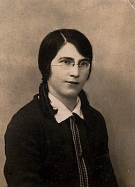
|
|
Marianna Ramotowska
(Rachela Finkielsztejn)
Early 1930's |
|
| |
|
Stanislaw Ramotowski decided right
after the slaughter to marry Rachela, daughter of the Jewish neighbors he'd
managed to hide. The village of Kramarzewo was part of the Wasosz parish, so he
went to Wasosz to organize Rachela's baptism and the wedding.
"I went to the presbytery," Ramotowski
told me. "There was a big table and five baking pans with a goose in each, on
their way into the oven. The priest said 'What are you going to pay me with, now
that cash has no value?' 'We have nothing, Father,' I said. He replied, 'Rings
or earrings will do, as long as they're golden.' I told him that Rachela's house
in Dziewiecin had been plundered so now there was nothing but broken windows
there. The priest said: 'Well, here's an example. There was one Chaim here, a
poor Jew with a sack on his back, but when they put a scythe to his throat' --
and he made the gesture with his hand -- 'it turned out he had dollars and
gold.' I just trembled, as if fire went right through me. He sent me outside to
wait, and did not ask me back in; he just handed me a note through the door,
telling me to give it to the priest in Radzilow and get married there. I climbed
my cart and opened the note, and it turned out he was telling the other priest
by no means to wed us. I just crumpled it and threw it away."
"It's clear he'd been taking Jewish
gold from the Wasosz murderers. He must have promised them dispensation and
those stupid peasants just brought him the gold."
"I rode to Radzilow, I was in a hurry
to talk to Father Dolegowski before he would contact the one from Wasosz. I
found him at a neighbor's house, playing cards. He was a good-natured man,
except that at first, he wanted six quintals of rye. I told him the Germans
would take less for faking the documents, and finally he agreed to go down to
three quintals. When my brother-in-law and I were loading the rye into his barn,
I saw it was full of grain that was obviously of no use because oxen were
eating it. A portion we could have lived on for three months and make it till
spring, was three hours' worth of eating for those oxen."
"I didn't realize," Ramotowski
continued, "what this marriage would get me into. They fooled me; I had always
been clever, and now I followed stupid people's advice. Someone reported about
our wedding, they started searching for me too. From then on, I was
stigmatized; we both had to go into hiding."
I asked if people talked about the
pogrom after the war.
"Only quietly or when drunk. Father Dolegowski came
caroling once; he was so fat it was hard to get him out of the
sleigh. I asked, 'Don't you mind, Father, when a murderer comes to church
wearing a Jew's stolen fur?' Everybody knew who was wearing Szlapak's fur. He
didn't answer. Marianna (that was the Christian name she adopted) was anxiously
pulling on my sleeve."
|
|
|
|
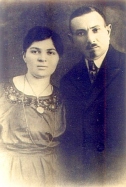 |
|
Szejna Bejla (Yaffa) (nee Kuberska)
and Moszk Dorogoj
Radzilow, 1920's-30's
Both killed in Radzilow |
|
|
| |
|
Marianna Ramotowska: "Two Jews named
Dorogoj, father and son, were killed right after the war. Kosmaczewski and his
brother called them to come in and have half a litre with them for
reconciliation, and then they killed them with axes in the hallway. They wanted
no witnesses. We were living in fear and kept getting robbed, and all sorts of
things happened. Some two years after the war they put a death sentence note on
my door. Just because I wanted to buy my family's oak-wood cupboard. I could
have bought a better one for the same money, but that one was a family heirloom.
It was a dark, three-part cupboard, with doors on the sides and two levels in
the middle."
Right after that note, Marianna had a
stillbirth. They could not have any more children after that.
I asked her whether anyone ever came to her and said, "I'm ashamed
of what the Poles did."
"No, but they weren't mean to us, either, because they knew we
wouldn't prosecute them. On the contrary, we would go and testify for them
whenever they were suspected of anything."
|
|
|
|
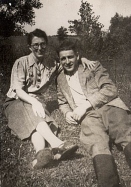
|
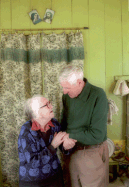 |
|
Marianna (Rachela Finkielsztejn)
& Stanislaw Ramotowski
[L] 1950's, [R] 2000 |
|
| |
|
Marianna Ramotowska's testimonies from the 50s somehow did not end
up destroyed and are still available in the Elk courthouse. She testified in
favor of three people who had taken part in the murder, including Leon Kosmaczewski.
"Kosmaczewski is reported to be one of the worst murderers. Did you
know what he had done?" I asked.
"Everybody knew about Kosmaczewski. But we would have helped any
murderer, we wouldn't have survived otherwise."
Her husband added: "For them killing a man was like killing a fly.
We were living here like sparrows in the bush. That's why no sentences were
passed in their trials: we were forced to defend them."
During the dozens of conversations I had with Ramotowski, he kept
bringing up new murderers.
"God forbid you should ever meet them,"
and he would give me anxious looks, talking about those long dead criminals.
"But the murderers themselves did not have an easy death, either. A friend of
mine was lying in hospital next to Felek's bed and told me he was calling the
Jews he'd murdered by their names. Death was coming and everything stood before
his eyes again. His family were trying to hush him down, and he was screaming,
'The hallway's full of them, make them go away.'"
For over sixty years, Marianna and
Stanislaw Ramotowski were never apart for a moment. The first time I saw them,
they looked as if they were posing for a photographer. He was sitting by her and
holding her hand. Later I realized they were spending most of the day that way.
"Stasinek," the weak-sighted Marianka would call him whenever he went out for a
minute. "I'm coming," he would answer patiently.
"Such was the destiny: she was to live
and I was selected to make it possible," Stanislaw Ramotowski told me before his
death.
After the war, eight of the murderers
were tried and, though it was in Stalinist times, the pogrom leaders were justly
accused. They had become active right after the departure of the Soviets, who
had been occupying the area until June 1941. They reached an agreement with the
Germans and then organized a civic guard, took control over the town and started
wearing white-and-red armbands. Witnesses remember they were wearing those
armbands on the day of the massacre. Their motives for conducting the massacre
were idealistic and patriotic. That is why Henryk Dziekonski kept insisting
during the trial that he had tried to prevent the robberies, urging the people
to burn down all the Jewish goods. He didn't want such a stain on his pure act
of ideology.
According to my calculations, seven of
them joined the Home Army, Poland's legendary underground force. |